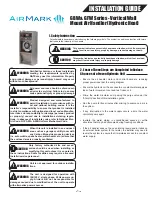
6
The valves should be sized according to
the capacity of the outdoor unit. Failure to
install the right valve can lead to poor per-
formance and possible compressor damage.
CAUTION
!
Ensure that the TXV bulb is in direct con-
tact with the suction/vapor line. Gap be-
tween the bulb and tube should be avoid-
ed. Failure to do so will impair the proper functioning of the
TXV valve.
CAUTION
!
I. TXV Bulb Horizontal Mounting
The orientation and location of the TXV bulb has a major influence
on the system performance.
If the TXV sensing bulb is mounted verti-
cally; the capillary MUST be directed up-
wards. The bulb must be mounted on the
wall opposite to that being directly hit by the refrigerant and
oil leaving the distributor tubes.
CAUTION
!
II. TXV Bulb Vertical Mounting
Fig 8B-3. Recommended location
for vertical TXV bulb mount
As recommended in Section
8B-I, the TXV sensing bulb
should be mounted in a hori-
zontal plane in relation to the
suction/vapor line. However,
some installation configura
-
tions may require that the
sensing bulb be mounted ver-
tically. In this instance, place
the bulb opposite the piping
wall being hit by refrigerant
and oil leaving the distributor
tubes, and with capillary tubes
directed upwards as shown in
Fig. 8B-3.
III-3.
Replace the Teflon O-ring
seal in place (located between
the halves).
O-ring
III-2.
Remove the existing flow
-
rator piston using a small wire
or pick.
Note: Photos are for basic illustration purposes only. Actual equip-
ment configuration may differ from that shown.
III. Field-Installed TXV Retrofit
When installing an expansion valve, it is not necessary to slide the
coil out of the housing.
III-1.
Disassemble the flowrator
body using two wrenches. Un-
screw the body with a counter-
clockwise motion.
Ensure that the TXV selected is compat-
ible with the refrigerant used in the out-
door system (R22 or R410A). TXV caps are
painted green for R22 or pink for R410A. In absence of col-
or, the caps will be marked with the compatible refrigerant.
CAUTION
!
The sensing bulb and TXV body MUST be
protected from overheating during braz-
ing. The sensing bulb and TXV body must
be covered using a quench cloth or wet cloth when brazing.
Pointing the brazing flame away from the valve and sensing
bulb provide partial protection only.
!
WARNING
It is recommended that the TXV bulb be installed parallel to the
ground (on a horizontal plane). The bulb position should be at
2 o’clock or 10 o’clock. Fig. 7B-2 shows the recommended position
for the TXV bulb installation in the horizontal plane.
The TXV sensing bulb SHOULD be mounted on the suction line ap
-
proximately 6” from the TXV or coil housing using the metal clamp
provided. In order to obtain a good temperature reading and correct
superheat control, the TXV sensing bulb must conform to ALL of the
following criteria:
1. The sensing bulb MUST be in direct and continuous
contact with the suction line.
2. The sensing bulb should be mounted horizontally on
the suction line.
3. The sensing bulb MUST be mounted at the 2 o’clock or
10 o’clock position on the circumference of the suction line.
4. The sensing bulb MUST be insulated from outside air.
A properly mounted sensing bulb will prevent false readings caused
by liquid refrigerant that may have formed inside the suction/vapor
line. Insulation will protect the sensing bulb from false readings due
to contact with warm air.
Fig 7B-2. Recommended location for horizontal TXV bulb mount
Bulb position at
2 o’clock or
10 o’clock
Содержание GBW Series
Страница 16: ...16 23 Massachusetts Applicable Installation Diagram ...
Страница 18: ...18 25 Massachusetts Applicable Installation Diagram ...
Страница 19: ...19 ...






































